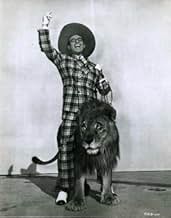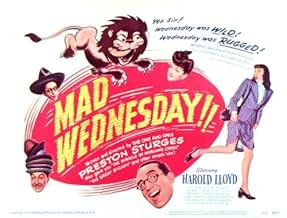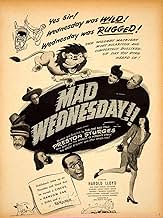IMDb RATING
6.3/10
1.8K
YOUR RATING
Harold is a mild-mannered clerk who dreams about marrying the girl at the desk down the aisle. But then he loses his job, and when he is offered a potent drink at a bar, he goes on a very st... Read allHarold is a mild-mannered clerk who dreams about marrying the girl at the desk down the aisle. But then he loses his job, and when he is offered a potent drink at a bar, he goes on a very strange and funny rampage (with a lion in tow).Harold is a mild-mannered clerk who dreams about marrying the girl at the desk down the aisle. But then he loses his job, and when he is offered a potent drink at a bar, he goes on a very strange and funny rampage (with a lion in tow).
- Awards
- 2 nominations total
- Director
- Writer
- All cast & crew
- Production, box office & more at IMDbPro
Featured reviews
A strange film. Written and directed by the brilliant filmmaker Preston Sturges, and starring silent film comedian Harold Lloyd (about 20 years after his prime), this movie tells the story of a college football hero who settles into a rut as he reaches middle age. Suddenly fired from his dead-end job, the milquetoasty Mr. Diddlebock uses his severance money to break out of his rut, embark on a series of adventures over a wild two or three days alongside a chance acquaintance, the aptly named Wormy (played by Sturges regular Jimmy Conlin), and pursue the woman of his dreams.
Even though this film lacks some of the subtlety, sophistication and polish of some of Preston Sturges' earlier work, it nevertheless (in true Sturges fashion) hides away some pretty heady ideas about growing old, taking chances, and living life to the fullest. this film, a minor entry in the Sturges catalog, would have been the crowning achievement in the career of anyone else. Watch this one, if only to find out what Harold really did on Wednesday!
Even though this film lacks some of the subtlety, sophistication and polish of some of Preston Sturges' earlier work, it nevertheless (in true Sturges fashion) hides away some pretty heady ideas about growing old, taking chances, and living life to the fullest. this film, a minor entry in the Sturges catalog, would have been the crowning achievement in the career of anyone else. Watch this one, if only to find out what Harold really did on Wednesday!
Harold Lloyd and Preston Sturges are in the same boat, really. In their respective times, they were beloved stars. Now, the rank and file don't really remember them, or if they do remember them it's for a limited selection of films which don't necessarily reflect their full bodies of work. For Lloyd, audiences really only know him as the guy who's always hanging from the clock in the Chuck Workman montages that pop up during award shows, no concept at all that he was, in his time, far more successful than Buster Keaton and on the same level as Chaplin. And for Sturges, only filmlovers really remember him, even though the best of his films, like Palm Beach Story and Sullivan's Travels are among the very best of their time.
Lloyd, of course, was a silent comedy icon. After the depression is career slumped and while he made a series of largely unsuccessful sound films trying to maintain the verve of his silent comedies, audiences simply were not interested. In 1947, though, he attempted another comeback in the film The Sins of Harold Diddlebock. Directed by Preston Sturges, Diddlebock capitalized on Lloyd's past rather than avoiding it. The film took the interesting question "What happened to Harold Lamb (Lloyd's character from The Freshman, his most popular silent film) after the Depression?" In doing so, the film also examined what happened to Lloyd's image.
Diddlebock opens with the final 10 minutes of The Freshman, the triumphant football game. Shifting to sound almost immediately after the final whistle, Lloyd's character goes from youthful exuberance to aged desperation. Following the game, we discover, Harold took a bookkeeping job at an ad agency hoping to move straight to the top. Like his character in Safety Last (the classic where he hangs from that big clock) all he wanted was the chance to pitch his one great idea. But that chance never came and nearly twenty years after he lost his savings in the Crash, Harold loses his job as well. Grey haired, face set in wrinkles, Harold goes into the world with only a small pension. But with the help of a night of drinking, a horse named after his aunt, a look-alike sister played by Margaret Hamilton (the Wicked Witch of the West), and an old boozehound named Worm, he reclaims his comic genius, briefly owns a circus with 37 lions, and, well, perhaps you can see where this late screwball comedy is going. Diddlebock went nearly a million dollars over budget and was reedited and renamed (to Mad Wednesday). It was a disaster.
Looking at the film objectively, many years later, it certainly isn't so bad. The central stylistic conceit is that the silent slapstick of Lloyd's age and the verbal acrobatics that made Sturges famous were not so different at all. Sturges goes so far as to change Lloyd's character's name from "Lamb" to "Diddlebock" to create a slapstick of nomenclature. Diddlebock also proves fairly conclusively that Lloyd's decline was not caused by an inability to handle speaking roles. In this film he keeps up his end of the witty repartee and even harmonizes in a chorus of "Auld Lang Syne." The film also pays homage to Safety Last's human fly scene with a skyscraper chase scene involving Lloyd and a lion. Even at 53, Lloyd was still fit enough to handle the stunts, including swinging upside down from a leash. And yet, for all of its charm, Diddlebock must have seemed out of place. By that point audiences probably didn't remember Lloyd and didn't want to remember the Depression.
The problem is that the film is just a little too clunky and, like the worst of Sturges's writing, relies largely on expositional monologues to justify plot contrivances. Also, the film just doesn't have the zip that Sturges's films had at their peak. Still, it's a pleasant combination of elements, capitalizing on Lloyd's considerable personal appeal, Sturges's talent (even low Sturges is better than, well, most things), and several members of Sturges's stock troupe, including Jimmy Conlin as drunk gambler Wormy. The fact that audiences of the time rejected it shouldn't have any impact on people with unjaded eyes viewing it today.
Look for the 90 minute version, by the way.
I'd give Harold Diddlebock a 7 out of 10. It's worth a look if you're a fan of either Lloyd or Sturges.
Lloyd, of course, was a silent comedy icon. After the depression is career slumped and while he made a series of largely unsuccessful sound films trying to maintain the verve of his silent comedies, audiences simply were not interested. In 1947, though, he attempted another comeback in the film The Sins of Harold Diddlebock. Directed by Preston Sturges, Diddlebock capitalized on Lloyd's past rather than avoiding it. The film took the interesting question "What happened to Harold Lamb (Lloyd's character from The Freshman, his most popular silent film) after the Depression?" In doing so, the film also examined what happened to Lloyd's image.
Diddlebock opens with the final 10 minutes of The Freshman, the triumphant football game. Shifting to sound almost immediately after the final whistle, Lloyd's character goes from youthful exuberance to aged desperation. Following the game, we discover, Harold took a bookkeeping job at an ad agency hoping to move straight to the top. Like his character in Safety Last (the classic where he hangs from that big clock) all he wanted was the chance to pitch his one great idea. But that chance never came and nearly twenty years after he lost his savings in the Crash, Harold loses his job as well. Grey haired, face set in wrinkles, Harold goes into the world with only a small pension. But with the help of a night of drinking, a horse named after his aunt, a look-alike sister played by Margaret Hamilton (the Wicked Witch of the West), and an old boozehound named Worm, he reclaims his comic genius, briefly owns a circus with 37 lions, and, well, perhaps you can see where this late screwball comedy is going. Diddlebock went nearly a million dollars over budget and was reedited and renamed (to Mad Wednesday). It was a disaster.
Looking at the film objectively, many years later, it certainly isn't so bad. The central stylistic conceit is that the silent slapstick of Lloyd's age and the verbal acrobatics that made Sturges famous were not so different at all. Sturges goes so far as to change Lloyd's character's name from "Lamb" to "Diddlebock" to create a slapstick of nomenclature. Diddlebock also proves fairly conclusively that Lloyd's decline was not caused by an inability to handle speaking roles. In this film he keeps up his end of the witty repartee and even harmonizes in a chorus of "Auld Lang Syne." The film also pays homage to Safety Last's human fly scene with a skyscraper chase scene involving Lloyd and a lion. Even at 53, Lloyd was still fit enough to handle the stunts, including swinging upside down from a leash. And yet, for all of its charm, Diddlebock must have seemed out of place. By that point audiences probably didn't remember Lloyd and didn't want to remember the Depression.
The problem is that the film is just a little too clunky and, like the worst of Sturges's writing, relies largely on expositional monologues to justify plot contrivances. Also, the film just doesn't have the zip that Sturges's films had at their peak. Still, it's a pleasant combination of elements, capitalizing on Lloyd's considerable personal appeal, Sturges's talent (even low Sturges is better than, well, most things), and several members of Sturges's stock troupe, including Jimmy Conlin as drunk gambler Wormy. The fact that audiences of the time rejected it shouldn't have any impact on people with unjaded eyes viewing it today.
Look for the 90 minute version, by the way.
I'd give Harold Diddlebock a 7 out of 10. It's worth a look if you're a fan of either Lloyd or Sturges.
Harold Lloyd was one of Hollywood's greatest physical comedians and actors of Buster Keaton and Charlie Chaplin generation. This film marks his final performance but he could have done so much more in film. Regardless, his contributions should not be overlooked. Harold Lloyd plays Harold Dibbledock, a former football players, who ends up at a dead-end job as a clerk for 22 years. His ungrateful boss sends him packing after he fires him for years of service which was more like a prison sentence than a job. He never relived his glory days on the field. When he encounters an old man who seeks a few dollars to play the horses, he begins a new life after he takes a drink. Until then, Harold has never drank alcohol. He awakens up to learn that he's changed and doesn't have a clue about it. Margaret Hamilton plays Flora in a small performance. Anyway, he learns that he's bought a cab with a driver and a horse and a circus. Anyway, the film's best scenes are stolen by Jackie, the lion. It's a good film!
In 1947 Preston Sturges and Harold Lloyd worked together and they came up with The Sin of Harold Diddlebock.It's a sequel for Lloyd's silent film classic The Freshman (1925).After this movie Mr.Lloyd retired from the movie business.In his last picture Harold plays a clerk who's fired from his job after twenty years.He ends up to a bar drinking and the man goes crazy.Also a lion in tow gets in a picture and lots of other funny stuff happens on a way.This movie may not be the best of Harold Lloyd, not even close, but it's mighty entertaining.And because of Harold Lloyd this movie works much better than it would have with some average comedian.Lloyd was far from average.He was Lonesome Luke and he was Glasses, which was the character that made him immortal.Lloyd may steal the show in this movie, but there are other great actors there.I could mention Jimmy Conlin, Raymond Walburn, Rudy Wallee and Edgar Kennedy.I recommend you to watch this film from 60 years back.For the Harold Lloyd fans it's a must.
The last laugh of any great clown is interesting, if only for its memento mori value. Laurel & Hardy's last film, UTOPIA, is sadly botched but moments of their grand comedy still flair up, like Marc Antony's final bravery in Shakespeare's Antony & Cleopatra. The grandiose W.C. Fields still holds his own in SONG OF THE OPEN ROAD, even though he was deathly ill with alcohol poisoning. The Marx Brother's LOVE HAPPY is mainly a vehicle for one last pantomime fling for brother Harpo -- and all the more poignant for it. Chaplin's KING IN NEW YORK is a splendid idea -- we chuckle at its conception -- though Chaplin conducts himself like a department store floorwalker more than a comedian. And Harold Lloyd's last movie seems to me to be a nostalgic conspiracy between him and director Sturges, a Last Hurrah to remind movie audiences one last time of the glorious slapstick & pantomime heritage that America was in the process of losing forever as the old clowns faded from the scene and brash lunatics like Martin & Lewis or Bob Hope took over the reins of comedy. Lloyd's film exists in several differently edited versions, but I won't call any of them "butchered", just misunderstood. By the late Forties there weren't any skilled editors around who could quite understand the cadence, the beat, the nearly-balletic timing that a great clown brought to the camera and needed the editor to highlight -- such things as double-takes, long shots of the chase and just stationary shooting when the clown is unfolding a gag. Lloyd produced a novel, a War & Peace, if you will, of vintage gags -- his editors only understood short stories or magazine articles. They grew nervous when the camera lingered on anybody or anything. But great comedy is just that -- lingering. In his final film Lloyd wants to loiter over gags silly and profound. His dawdling is cut short and the truncated comedy that follows seems at times stiff and childish. But before Harold is relegated to the dusty shadows he still pulls off much nonsense that is both genial and brassy -- not a coming attraction, but a dignified retreat back to the Land of Belly Laughs. Anyone grounded in American cinematic comedy feels abit like one of the children in the story of the Pied Piper; we wish we could go with him back into that wonderful, magical, mountain.
Did you know
- TriviaDuring the scene where Harold Lloyd's character meets Jackie the lion, on the first take when Lloyd pets Jackie, the lion actually bit him on his right hand. However, he was not injured because the lion's teeth scraped against his two prosthetic fingers (Lloyd had lost most of his right hand in an on-set accident in 1919). After that, he refused to pet the lion ever again on- or off-screen, and in the second take, which was used for the film, his terrified squirming over the lion standing next to him is genuine.
- GoofsThe story takes place in New York. It is odd to see Los Angeles City Hall in the background of the final shot.
- Crazy credits"... and for the first time a young girl called Frances Ramsden playing the youngest Miss Otis"
- Alternate versionsOriginally released at 90 minutes; was then re-edited and re-released in a shorter 79-minutes version under the title "Mad Wednesday" in 1950.
- ConnectionsEdited from Vive le sport! (1925)
- SoundtracksAmerica, the Beautiful
(uncredited)
Music by Samuel A. Ward
Played during the presidential calendar montage
- How long is The Sin of Harold Diddlebock?Powered by Alexa
Details
- Release date
- Country of origin
- Language
- Also known as
- The Sin of Harold Diddlebock
- Filming locations
- Memorial Stadium - Stadium Rim Way, Berkeley, California, USA(football scenes edited from The Freshman)
- Production company
- See more company credits at IMDbPro
Box office
- Budget
- $1,712,959 (estimated)
- Runtime1 hour 29 minutes
- Color
- Aspect ratio
- 1.37 : 1
Contribute to this page
Suggest an edit or add missing content



























